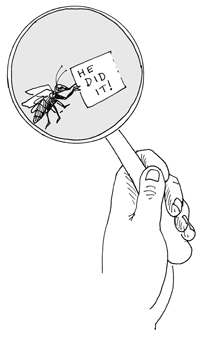STRANGE BUT TRUE- Once bitten: Insect evidence ID's scofflaws

DRAWING BY DEBORAH DERR McCLINTOCK
Q. Would-be crime busters, got a bug for biology? Then forensic entomology might be for you. What sorts of cases might come winging your way? –S. Holmes
A. In a classic 1850 case, a French plasterer uncovered a baby's body lodged behind a mantelpiece, and the question for the court became whether the current or previous occupants should be suspected. The discovery of mite eggs and blow fly larvae at autopsy put the time of death in 1848, clearing the present residents.
In Ventura County, California, in 1982, police noted chigger bites on a murder suspect similar to ones they themselves sustained where the body was found, in a remote area under a eucalyptus tree. An entomologist, studying various locales, identified chiggers only at the site in question, implicating the suspect (who had denied being anywhere near there).
While investigating a rape, Chicago police found a ski mask in a suspect's apartment like the one used in the crime, but the man claimed not to have worn it in more than a year. Analysis turned up two cockleburs stuck to the cloth and containing live weevil larvae of a type that wouldn't have survived the winter in a warm apartment– entomological evidence that helped lead to a conviction.
Q. "Cyborgs" like RoboCop (1987) that combine humans and machines might seem the most far-fetched of film creations. Could they ever make the long leap into reality? –Hal
A. The seeds of these fictional hybrids already exist, says Sidney Perkowitz in Hollywood Science. In 2000, a Northwestern University researcher installed part of the living brain of a sea lamprey, an eel-like fish, into a small wheeled robot. Via implanted electrodes, the brain was connected to light sensors on the robot and to motors controlling its wheels, powering the brain-driven robot toward or away from light sources. Going even further, Miguel Nicolelis at Duke University implanted electrodes into a monkey's brain (the brain lacks pain sensors) to connect the animal to an artificial arm that mirrored the movements of the monkey's real arm. "Eventually, Nicolelis could train the monkey so that merely thinking about moving its arm moved the robotic arm correspondingly," Perkowitz says.
Then neurologist Phillip Kerney implanted electrodes into the brain of a stroke patient who could barely move. With training, the patient learned to move a computer screen cursor by thought alone! He could pick out letters to spell words, opening up for him once again the "blessing of communicating" with other people.
All of these show that "hybrid connections are feasible, with potential to help the injured and even to expand human physical and mental capacities– just as RoboCop is stronger and a better shot than any human policeman."
Q. There's obvious charm in your parrot imitating what you say, but what could be the point of such mimicry capability for species in the wild? –L. J. Silver
A. You and your parrot occupy a select niche in the animal kingdom: the ability to learn vocal signals is
restricted to songbirds and hummingbirds and parrots among birds, humans and bats and whales among mammals, says biologist Timothy F. Wright.
Depending on the species, the regional "dialects" that arise from large numbers of wild birds imitating each other may help males and females from similar areas find one another, says avian biologist Michael Schindlinger in Scientific American magazine. Regional song learning may also allow territorial neighbors to become familiar and help identify drifters. Further, imitative vocal learning is a ready-made display of healthy neural functioning that embraces hearing, memory, muscle control for sound production– all potentially important in mate selection.
Send Strange questions to brothers Bill and Rich [email protected].
#